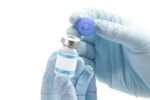Gene Therapy Potentially Better Than ERT for Pompe, Study Shows

Gene therapy given with chaperones — specific molecules known to stabilize the structure of proteins — was found to enhance the availability of acid alpha-glucosidase, known as GAA, the missing or defective enzyme in Pompe disease (PD), in a mouse model.
The treatment subsequently eased disease symptoms, with the mice showing significantly improved muscle strength compared with both untreated animals (controls) and those given standard enzyme replacing therapy or ERT.
These findings suggest that gene therapy is more effective than ERT, the current standard of care, for treating Pompe. In addition, positive safety data obtained in rhesus monkeys further support the development of this gene therapy in clinical trials.
“Here, we demonstrated that gene transfer with secretable GAA holds enhanced therapeutic potential when compared to standard of care ERT,” the scientists wrote.
The study, “Hepatic expression of GAA results in enhanced enzyme bioavailability in mice and non-human primates,” was published in the journal Nature Communications.
In Pompe, mutations in the GAA gene, which encodes instructions to make the GAA enzyme, either prevent its production or result in the abnormal production of a non-functional enzyme. Lack of GAA causes the accumulation of glycogen, a complex sugar molecule, in tissues and also affects autophagy, a process by which the cells clean out damaged or unnecessary components.
The current standard treatment, ERT, involves the intravenous (into-the-vein) administration of a lab-made human form of the GAA enzyme, called rhGAA. However, in some people with the most severe infantile-onset form of Pompe, the immune system attacks and neutralizes rhGAA. Additionally, the efficacy of ERT is limited because it does not stay in circulation for very long, and its uptake in different tissues is variable.
Therefore, several clinical trials (for example, NCT03533673) have been exploring the use of adeno-associated virus (AAV) vectors. AAV are viruses that have been rendered harmless and are engineered to deliver a healthy copy of the GAA gene to the liver to produce a secretable version of the enzyme.
In this study, a team of scientists from France and the U.S. aimed to evaluate how AAV moves through the body, and its effectiveness compared with ERT, in a mouse model of Pompe. The team included researchers from Spark Therapeutics and Genethon.
For their experiments, the team used immunodeficient mice so that the immune system would be prevented from attacking rhGAA. These mice were then crossed with mice lacking the GAA enzyme to create a PD mouse model.
These immunodeficient PD mice were then treated with the standard regimen of rhGAA, at 20 mg/kg, every two weeks, for four months, or with a single injection of gene therapy at a low, intermediate, or high dose.
By the end of the study, the GAA enzyme was hardly detectable in the ERT-treated mice. However, GAA was still found in circulation in all mice treated with the gene therapy.
After four months, mice treated with the two higher doses of gene therapy had higher protein levels of GAA in heart and skeletal muscles compared with ERT-treated mice. Their muscle strength significantly improved compared with ERT-treated and untreated animals.
According to the researchers, the accumulation of glycogen in the central nervous system or CNS, comprised of the brain and spinal cord, is appearing as a contributing feature to the development of Pompe disease. GAA activity in the brain and spinal cord significantly increased in mice treated with the highest gene therapy dose.
The team found a dose-dependent reduction in glycogen content in the brain and spinal cord of mice treated with gene therapy compared with controls, unlike ERT-treated mice. Animals receiving gene therapy showed complete normalization of glycogen levels in the heart, diaphragm — a dome-shaped muscle key for respiration, or breathing — and muscle and arm muscles. Meanwhile, those on ERT showed such glycogen level reduction in the heart only.
“Together, these results show that, differently from [liver] AAV gene transfer with secretable GAA, ERT is inefficient in clearing glycogen in the CNS of PD mice when given at the dose of 20 mg/kg every 2 weeks,” the investigators wrote.
Other superior effects of gene therapy compared with ERT included restoring autophagy and mitochondrial function. Of note, the mitochondria are the energy-producing organelles of the cells.
Next, the team investigated the effect of combining chaperones with gene therapy. Two chaperones were tested, 1-Deoxynojirimycin, also called duvoglustat, and ambroxol. Both compounds had been reported to improve GAA activity.
Using the two chaperones in ERT-treated mice resulted in higher GAA activity in the blood compared with ERT alone, the researchers confirmed.
Mice treated with gene therapy and chaperones had increased GAA in several muscle groups and in the spinal cord. Glycogen clearance also was improved in most muscles, in addition to the increased muscle strength shown. Additionally, cardiomegaly, also known as enlarged heart, was completely rescued only in animals that received chaperone treatment.
“Together, these results further support the hypothesis that stable circulating levels of GAA increase the enzyme bioavailability,” the team wrote. “They also show the improved efficacy of a therapeutic strategy based on the combination of AAV gene transfer with a pharmacological treatment enhancing GAA enzyme stability and biodistribution.”
To assess the safety of gene therapy, the scientists used rhesus monkeys. Three ascending doses of gene therapy — specifically Spark’s investigational gene therapy for Pompe SPK-3006 — were evaluated and liver function tests, as well as other lab tests, confirmed its safety. Additionally, GAA was detected in the heart, skeletal muscle, spinal cord, brain, and diaphragm.
Based on these positive results, SPK-3006 is being tested in a Phase 1/2 trial called RESOLUTE (NCT04093349). The trial, sponsored by Spark, is assessing SPK-3006 in adults with late-onset Pompe disease on ERT, and is currently enrolling.
“These results support the safety and feasibility of expressing secretable GAA in liver to target peripheral tissues. Importantly, our data suggests that the stable amounts of circulating GAA achieved through efficient liver gene transfer may facilitate enzyme uptake through the blood-brain barrier [into the CNS],” the investigators concluded.








